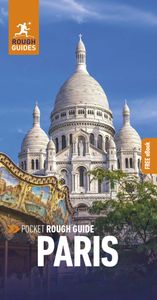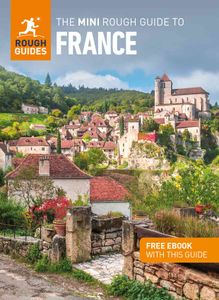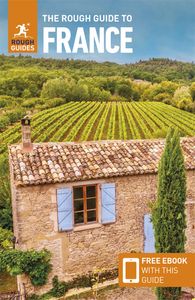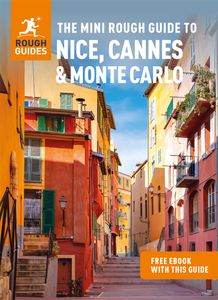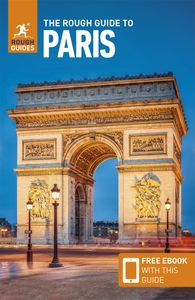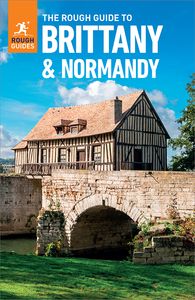The Ardennes
To the northeast of Reims, the scenery of the Ardennes region along the Meuse valley knocks spots off any landscape in Champagne. Most of the hills lie over the border in Belgium, but there’s enough of interest on the French side to make it well worth exploring.
In war after war, the people of the Ardennes have been engaged in protracted last-ditch battles down the valley of the Meuse, which, once lost, gave invading armies a clear path to Paris. The rugged, hilly terrain and deep forests (frightening even to Julius Caesar’s legionnaires) helped World War II Resistance fighters, but during peacetime life here has never been easy. The land is unsuitable for crops, and the slate and ironworks, the main source of employment during the nineteenth century, closed in the 1980s. The only major investment in the region has been a nuclear power station, to which locals responded by etching “Nuke the Élysée!” high on a half-cut cliff of slate just downstream. This said, tourism, the main growth industry, is developing apace – there are walking and boating possibilities, plus good train connections – though the isolated atmosphere of this region still lingers.
Charleville-Mézières
Charleville-Mézières – an agglomeration of former stand-alone towns Charleville and Mézières – provides a good base for exploring the northern part of the region, which spreads across the meandering Meuse before the valley closes in and the forests take over.
The splendid seventeenth-century place Ducale, in the centre of town, was the result of the local duke’s envy of the contemporary place des Vosges in Paris, which it somewhat resembles. Despite the posh setting, the shops in the arcades remain down-to-earth and the cafés charge reasonable prices to sit outside.
Puppets in Charleville
Charleville is a major international puppetry centre (its school is justly famous), and every two years it hosts one of the largest puppet festivals in the world, the Festival Mondial des Théâtres de Marionnettes. For ten days in September, up to 250 professional troupes – some from as far away as Mali and Burma – put on around fifty shows a day on the streets and in every available space in town. Tickets are cheap, and there are shows for adults as well as the usual stuff aimed at kids. If you miss the festival, you may still be able to catch one of the occasional puppet performances at the Institut de la Marionette (03 24 33 72 50) on place Winston Churchill.
Champagne: the facts
Nowhere else in the world are you allowed to make a drink called champagne, though many people do, calling it “champan”, “shampanskoye” and all manner of variants. You can blend grape juice harvested from chalk-soil vineyards, double-ferment it, store the result for years at the requisite constant temperature and high humidity in sweating underground caves, turn and tilt the bottles little by little to clear the sediment, add some vintage liqueur, and finally produce a bubbling golden (or pink) liquid; but according to European law you may refer to it only as “méthode traditionnelle”. The jealously guarded monopoly helps keep the region’s sparkling wines in the luxury class, although the locals will tell you the difference comes from the squid fossils in the chalk, the lay of the land and its climate, the evolution of the grapes, the regulated pruning methods and the legally enforced quantity of juice pressed.
Three authorized grape varieties are used: chardonnay, the only white grape, grown best on the Côte des Blancs and contributing a light and elegant element; pinot noir, grown mainly on the Montagne de Reims slopes, giving body and long life; and pinot meunier, cultivated primarily in the Marne valley, adding flowery aromas.
The vineyards are owned either by maisons, who produce the grande marque champagne, or by small cultivators called vignerons, who sell the grapes to the maisons. The vignerons also make their own champagne and will happily offer you a glass and sell you a bottle at two-thirds the price of a grande marque (ask at any tourist office in the Champagne region for a list of addresses). The difference between the two comes down to capital. The maisons can afford to blend grapes from up to sixty different vineyards and to tie up their investment while their champagne matures for several years longer than the legal minimum (one year for non-vintage, three years vintage). So the wine they produce is undoubtedly superior.
If you could visit the head offices of Cartier or Dior, you’d probably find the atmosphere similar to that of the champagne maisons, whose palaces are divided between Épernay and Reims. Visits to the handful that organize regular tours are not free, and most require appointments, but don’t be put off – their staff all speak English and a generous dégustation is thrown in. Their audiovisuals and (cold) cellar tours are on the whole very informative, and do more than merely plug brand names. Local tourist offices can provide full lists of addresses and times of visits.
If you want to work on the harvest, contact any of the maisons direct or Pôle Emploi Vendanges (03 177 86 39 49)
Épernay
There’s no question that Épernay, 26km south of Reims, is a single-industry town. But it’s beautifully situated below rolling, vine-covered hills, and the industry in question – champagne production – is a compelling reason for a visit. The town contains some of the most famous champagne maisons as well as several smaller houses so start at the appropriately named avenue de Champagne, running east from place de la République. Dubbed “the most drinkable street in the world” by Winston Churchill, it’s worth strolling along for its imposing eighteenth- and nineteenth-century champagne maisons. You can tour some of them, and many others welcome visitors to taste and buy. The town makes a sensible base for exploring the surrounding villages and vineyards.
De Castellane
A fifteen-minute walk from the train station, De Castellane provides Épernay with its chief landmark: a pastel edifice resembling a kind of Neoclassical water tower. Along with the cellars, the visit shows off the working assembly lines that fill the champagne bottles, and the huge vats that hold the grape juice prior to fermentation. After the tour you can wander the little museum and climb the tower for a great view of the surrounding vineyards.
Mercier
Mercier runs a fairly rewarding tour around its cellars in an electric train. Nowadays the wine producer is known for being at the lower end of the champagne market in terms of price, demonstrating that M. Mercier has achieved his ultimate goal: he founded the house, aged 20, in 1858 with a plan to make champagne more accessible to the French people. In 1889 he carted a giant barrel that held 200,000 bottles’ worth to the Paris Exhibition – only to be upstaged by the Eiffel Tower. The barrel is on display in the lobby.
Moët et Chandon
The largest, and probably the most famous maison, though neither the most beautiful nor necessarily the most interesting to tour, is Moët et Chandon, one of the keystones of the LVMH (Louis Vuitton, Moët and Hennessy) empire which owns Mercier, Veuve Clicquot, Dior perfumes and other luxury brands. The house is also the creator of the iconic Dom Pérignon label. All tours end with a tasting of their truly excellent champagne, with the €35 option including a glass of both the white and rosé Grand Vintage.
The Plateau de Langres
The Seine, Marne, Aube and several other lesser rivers rise in the Plateau de Langres between Troyes and Dijon, with main routes between the two towns skirting this area. To the east, the D619 (which the train follows) takes in Chaumont and Langres, two towns that could briefly slow your progress if you’re in no hurry, and the home village of Charles de Gaulle, Colombey-les-Deux-Églises.
Chaumont
Situated on a steep ridge between the Marne and Suize valleys, Chaumont (Chaumont-en-Bassigny, to give its full name), lies 95km southeast of Troyes. Approach by train to cross the town’s stupendous mid-nineteenth-century viaduct, which took an average of 2500 labourers working night and day two years to construct. It’s also possible to walk across the viaduct, which gives you fine views of the Suize valley.
The town’s most interesting historic building is the Basilique St-Jean-Baptiste. Though built with the same dour, grey stone of most Champagne churches, it has a wonderful Renaissance addition to the Gothic transept of balconies and turreted stairway, and a superb church organ. The decoration includes an Arbre de Jessé of the early sixteenth-century Troyes school, in which all the characters are sitting in the tree, dressed in the style of the day.
You shouldn’t leave without taking a look at Les Silos, a 1930s agricultural co-op transformed into a graphic arts centre and médiathèque. As well as hosting temporary exhibitions, it’s the main venue for Chaumont’s international poster festival (Festival international de l’affiche), which is held every year from mid-May to mid-June. As for the rest of the old town, there’s not much to do except admire the thirteenth-century castle keep of the Comtes de Champagne, the delightfully named Tour d’Arse at the foot of the vieille ville,and the strange, bulging stair towers of the houses.
Colombey-les-Deux-Églises
Twenty-seven kilometres northwest of Chaumont, on the D619 to Troyes, is Colombey-les-Deux-Églises, the village where Gaullist leaders come to pay their respects at the grave of Général Charles de Gaulle. The former president’s family home, La Boisserie opens its ground floor to the public but more impressive are the pink-granite Cross of Lorraine, symbol of the French Resistance movement, standing over 40m high on a hill just west of the village, and the Mémorial Charles de Gaulle, an exhaustive chronicle of the man’s life and times in an ultra-sleek museum beneath the cross. It was inaugurated in 2008 with much pomp by Nicolas Sarkozy and German Chancellor Angela Merkel on the fiftieth anniversary of the rapprochement between de Gaulle and then-German Chancellor Konrad Adenauer.
Langres
Langres, 35km south of Chaumont and just as spectacularly situated above the Marne, retains its near-complete encirclement of gateways, towers and ramparts. If you’re just here for an hour or so, the best thing to do is to walk this circuit, with its great views east to the hills of Alsace and southwest across the Plateau de Langres. Don’t miss the St-Ferjeux tower with its beautiful metal sculpture, Air and Dreams. Wandering inside the walls is also rewarding – Renaissance houses and narrow streets give the feel of a place time has left behind, swathed in the mists of southern Champagne.
Langres was home to the eighteenth-century Enlightenment philosopher Diderot for the first sixteen years of his life, and people like to make the point that, were he to return to Langres today, he’d have no trouble finding his way around. The Musée d’Art et Histoire on place du Centenaire near the cathedral, duly devotes a section to Diderot, including his encyclopedias and various other first editions of his works, plus a portrait by Van Loos. The highlight of the museum is the superbly restored Romanesque chapel of St-Didier in the old wing, which houses a fourteenth-century which houses painted ivory Annunciation.
Eating and drinking
Langres has its own highly flavourful, strong-smelling – and excellent – cheese, which you can buy at the Friday market on place Bel’Air.







